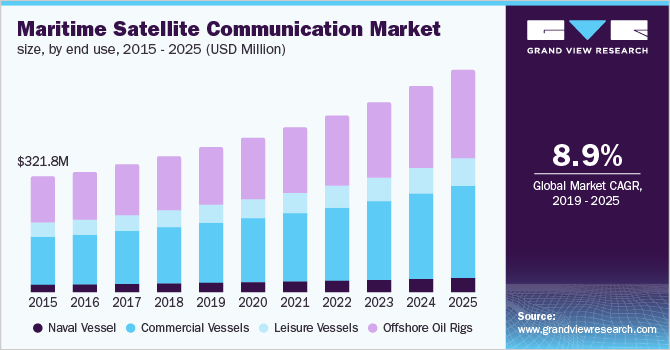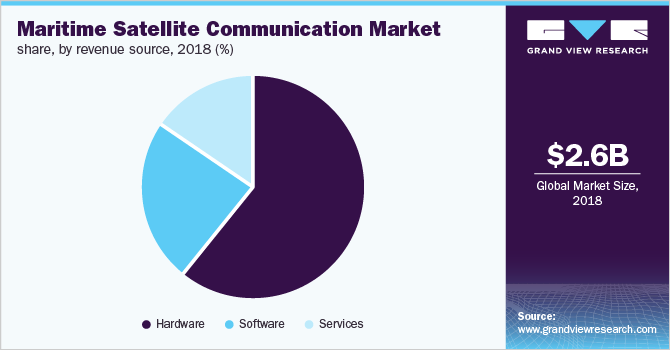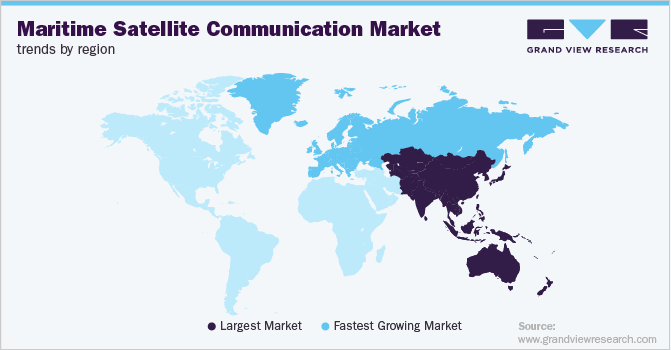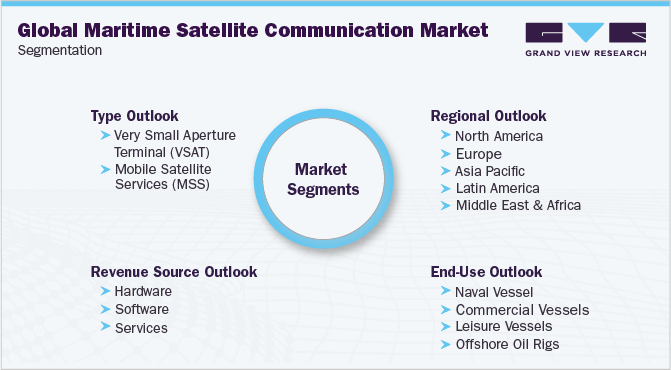
Maritime Satellite Communication Market Size, Share & Trends Analysis Report By Type (VSAT, MSS), By Revenue Source (Hardware, Software, Services), By End Use, By Region, And Segment Forecasts, 2019 - 2025
- Report ID: GVR-4-68038-049-1
- Number of Report Pages: 83
- Format: PDF, Horizon Databook
- Historical Range: 2014 - 2017
- Forecast Period: 2019 - 2025
- Industry: Technology
Report Overview
The global maritime satellite communication market size to be valued at USD 4.74 billion by 2025 and is expected to grow at a compound annual growth rate (CAGR) of 8.9% during the forecast period. The rising need for reliable and cost-effective communication services at sea is driving the growth. Moreover, increasing adoption for navigational purposes is also expected to fuel revenue growth. Also, huge investments by key maritime communication equipment manufacturers, such as iridium Communications Inc., and Inmarsat Global Limited, to introduce new and affordable equipment are expected to boost the growth.

Maritime telecommunication equipment has become the standard for short as well as long-term voyaging. Reliable communication has become an indispensable part of maritime transport, whether it's recreational boats, mega yachts, commercial fishing, or other naval transport. Cellular services are only available within the offshore areas and have a limited range wherein they function properly. A Satellite network is used as a solution to mitigate communication issues and offer services that have a competitive advantage over land-based communications.
In the past, satellite network was used for communication of ship to shore and with other marine vessel. Now the role of satellite communication has transformed from voice calls to additional user-oriented data services, such as entertainment, tracking, and monitoring services. These equipment have become ubiquitous owing to their diverse applications, such as DTH broadcasting, disaster management, voice calls, weather forecasting, and navigation among others.
Receiver, transmitter/transponder, transceiver, antenna, modem/router, and satellite phone are the prominent communication equipment deployed on marine vessels. This equipment also finds application in air and marine navigation and meteorological monitoring. Although marine satellite communications are becoming ever more crucial, the solutions that work on land do not typically operate at seas. Continuous R&D in the field is leading to minimizing the size of antennas and increasing the rate of data transfer to reduce the time lag. This factor is positively influencing the growth of the market.
Marine satellite communication equipment used for naval defense forces helps deal with aerial monitoring, sending and receiving a distress calls, and navigational requirements. Moreover, growing investment across various regions to upgrade legacy systems in the naval fleet is likely to propel demand over the forecast period. The defense and security sector has to maintain communications with zero time lag to evade challenges, such as pirate activities, inter-country conflicts, and border infiltrations among others. Thereby, marine satellite communication is gaining attention among coast guards, naval forces, and other security organizations.
Maritime Satellite Communication Market Trends
The growing need for applications like voice communications in the industry like passenger ships, fishing, and marine shipping is expected to fuel the satellite communication industry's expansion. Maritime satellite communication systems help in effective operations of these industries along with that it also enhances the security and surveillance system.
The rising adaptation of advanced satellite systems and big data computing applications, along with the increasing awareness about the benefits of the cloud solution, are among the primary factors driving the market further. Moreover, an increase in the integration of satellite and mobile communication technologies is expected to create new opportunities for the market.
However, customers are facing difficulties running satellite systems as the use of technology in maritime satellites rises. The vendors of maritime satellites fail to deliver reliable communication solutions, resulting in communication equipment and services being unable to function properly in adverse weather conditions. As a result, satellite communication network operators face a challenge in providing better service to their consumers regardless of weather conditions.
Type Insights
The Very Small Aperture Terminal (VSAT) segment captured a higher market share in 2018 and is expected to witness considerable growth during the forecast period. This growth is attributed to the advantages of VSAT over Mobile Satellite Services (MSS), such as reduced time lag, global coverage, and others. A Broadband VSAT network is used for establishing onboard VPN networks that cover fleets and connect ships to shore. This connectivity supports critical business applications, carries VoIP traffic, and increases ships’ access to information. VSAT provides regular access to the Internet for email, file sharing, and instant messaging, among others. VSAT has also provided the option of unlimited data usage at a fixed monthly payment. This enables the crew to stay in touch with friends and family, manage personal affairs, and consume entertainment content at a reasonable rate.
Although the market is undoubtedly heading toward an era of enhanced marine connectivity, research suggests that MSS will continue finding a place on vessels and platforms where data usage is minimal. For instance, fishing boats, are expected to adopt VSAT solutions at a slower rate and will continue with existing MSS equipment in the forthcoming years. Furthermore, if Arctic Circle once again recedes to open up northern shipping passages, MSS L-band will be the only feasible satellite connectivity solution in such extreme geographical locations. Furthermore, L-band is exceptionally reliable, outperforming some VSAT solutions in adverse climatic conditions, and will, therefore, be used as a backup for several years to come. This is owing to the frequency of VSAT causing the signal to be attenuated during rain showers and adverse climatic conditions at the water.
End-Use Insights
The commercial vessel segment accounted for revenue of over USD 1.3 billion in 2018, owing to the rising trade activities using commercial vessels; in key emerging countries such as China, Brazil, and India among others. The international shipping industry is responsible for the carriage of around 90% of world trade. Maritime trade continues to expand, bringing benefits for consumers across the globe through competitive logistics costs. With rising manufacturing and global trade, there has been a rise in the number of marine vessels added to the existing fleet. An increase in the number of ships and naval vessels is expected to fuel the market over the forecast period.
Rising globalization and supportive trade policy, as well as some geopolitical shifts such as the emergence of China as the manufacturing hub, constitutes a rise in maritime trade in the Asia Pacific. According to the UNCTAD Maritime Transport outlook 2018, maritime trade expanded by 4% in 2017, which is the fastest growth registered in five years. It is expected to exhibit similar growth in the upcoming years. Volumes across all segments witnessed growth in 2018, with dry bulk and containerized commodities recording significant progress on account of increasing tanker volumes. UNCTAD projected an average year-on-year growth rate in total volumes of 3.8 % till 2023. The increase in global trade and rising maritime fleet to cater to the demand for logistics are expected to boost the market over the forecast period.
Revenue Source Insights
Hardware was the dominant segment in 2018, accounting for more than 30% of market share in terms of revenue, and is expected to maintain its dominance over the forecast period. Hardware components are utilized in large volumes and the cost associated with them is very high. This high cost is likely to positively impact revenue generation over the forecast period. A rise in the installation of VSAT broadband equipment in new as well as existing marine vessel fleets is anticipated further fuel the market growth. Technological innovations, such as the reduced size of dish and cost of data usage is expected to drive the demand for the installation of new VSAT services over MSS services.

The software segment is poised to witness moderate growth during the forecast period, attributed to the accessibility of a wide range of application-specific software that suits the interests and requirements of marine vessels. For instance, satellite tracking and prediction, simulations and graphical interfaces, radio tuning with automatic Doppler correction, antenna steering through popular interfaces, and navigational and entertainment software. Increasing adoption of marine satellite communication equipment in defense vessels, cruise ships, luxury yachts, and others is anticipated to further drive the segment.
Regional Insights
Asia Pacific is projected to emerge as a predominant region over the forecast period owing to the increasing adoption of VSAT technologies in the merchant and cruise ships in the region. A large-scale modernization of legacy systems, such as close-in air defense systems, radar and communication systems in defense vessels, and a rise in political tensions and border disputes in the countries, such as India and China is also driving the demand for new satellite communication technologies in the region.

Europe is expected to witness the second-fastest growth over the forecast period, owing to the increased sales of luxury vessels. The demand is majorly driven by factors, such as the increasing number of High-Net-Worth Individuals (HNWI) and the rising popularity of marine tourism owing to the rising popularity of water sports and fishing. In the upcoming years, passenger traffic in marine and coastal tourism is expected to witness a substantial rise due to the attractiveness of the region. Introduction of tourism supportive policies, such as on-arrival visa is anticipated to boost investments in coastal areas for recreational activities, such as fishing, white-water rafting, kayaking, sail training adventures, one-day boating adventures, scuba diving, free diving, and snorkeling. These luxury vessels are equipped with the latest satellite communication technology. The rise in sales of these luxury vessels will positively impact the market.
Key Companies & Market Share Insights
The key market incumbents are undertaking initiatives and adopting strategies, such as business partnerships, mergers and acquisitions, and competitive pricing to capture greater market share.
In August 2018, Al Yah Satellite Communication Company PJSC (Yahsat), a provider of satellite telecom services based in the United Arab Emirates (UAE), acquiredThuraya Telecommunications Company for mobile satellite services. This acquisition will help the former to expand its customer base and services and gain greater market share in the near future.
In March 2019, Singapore Technologies Engineering Ltd., a provider of products and services related to aerospace, land defense systems, and marine capabilities for defense and commercial enterprises, acquired Belgium-based satellite telecom provider Newtec Group. It has a global customer base and this acquisition will help the former to reach a greater customer base on a global scale. Some of the key manufacturers include:
-
Inmarsat Global Limited
-
Iridium Communications Inc.
-
Leonardo S.p.A.
-
Thuraya Telecommunications Company
-
ViaSat Inc.
-
Orbcomm Inc.
-
KVH Industries, Inc.
-
Singapore Technologies Engineering Ltd
-
EchoStar Corporation
-
Kongsberg Maritime AS
-
Saab ABRohde & Schwarz GMBH.
Recent Developments
-
In June 2023, Inmarsat Maritime, a global satellite communication company, reached an agreement with Atlantic Offshore to implement Fleet LTE across Norwegian offshore. This agreement will ensure continuous high-speed, low-latency maritime satellite communication in the North Sea.
-
In June 2023, Inmarsat Maritime, announced the launch of its new Fleet Reach costal LTE service for maritime satellite communication. The launch will bring uninterrupted high-speed broadband to merchant, offshore, and fishing customers.
-
In May 2023, Viasat Inc., a global communication company, announced the acquisition of Inmarsat. This combination of the two companies will help connect the world more affordably and securely across land, maritime, and air.
-
In October 2022, AXESS Networks Maritime, a global company of satellite-based maritime communications, announced a strategic partnership agreement with Viasat. The agreement will lead to the global expansion of maritime satellite communication by delivering a wide range of solutions and services.
-
In October 2022, Iridium Communications Inc., a global satellite communication company, announced that along with its partners MetOcean Telematics, NAL Research, and Trace Systems will provide service for U.S. government customers.
-
In June 2022, WISeKey, a leading global cybersecurity company launched 7 new WISeSat FOSSA satellites in cooperation with FOSSA. This collaboration created the largest IoT constellations in European history.
-
In May 2022, Viasat, a global leader in the communication industry has been selected by Southwest Airlines for its in-flight connectivity. The advanced Ka-Band satellite of Viasat is anticipated to enhance internet connectivity along with the ability to watch online TV and stream content onboard.
-
In February 2022, Thuraya telecommunication company, a satellite solution provider signed an agreement with Delnet International Corporation to provide and sell advanced satellite solutions. This agreement is expected to enable Thuraya to expand its customer base in emerging markets of the Philippines
Maritime Satellite Communication Market Report Scope
|
Report Attribute |
Details |
|
Market size value in 2020 |
USD 3.0 billion |
|
Revenue forecast in 2025 |
USD 4.7 billion |
|
Growth Rate |
CAGR of 8.9% from 2019 to 2025 |
|
Base year for estimation |
2018 |
|
Historical Data |
2014 - 2017 |
|
Forecast period |
2019 - 2025 |
|
Quantitative units |
Revenue in USD billion and CAGR from 2019 to 2025 |
|
Report coverage |
Revenue forecast, company ranking, competitive landscape, growth factors, and trends |
|
Segments covered |
Type, revenue source, end use, and region. |
|
Regional scope |
North America; Europe; Asia Pacific; Latin America; MEA |
|
Country scope |
U.S.; Canada; U.K.; Germany; France; China; Japan; India; Mexico; Brazil |
|
Key companies profiled |
Inmarsat Global Limited; Iridium Communications Inc.; Leonardo S.p.A.; Thuraya Telecommunications Company; ViaSat Inc.; Orbcomm Inc.; KVH Industries, Inc.; Singapore Technologies Engineering Ltd; EchoStar Corporation; Kongsberg Maritime AS; Saab AB; and Rohde & Schwarz GMBH. |
|
Customization scope |
Free report customization (equivalent up to 8 analysts working days) with purchase. Addition or alteration to country, regional & segment scope. |
|
Pricing and purchase options |
Avail customized purchase options to meet your exact research needs. Explore purchase options |
Global Maritime Satellite Communication Market Segmentation
This report forecasts revenue growth at the global, regional, and country levels and provides an analysis of the latest industry trends from 2014 to 2025 for each of the sub-segments. For the purpose of this study, Grand View Research has segmented the global maritime satellite communication market report on the basis of type, revenue source, end-use, and region:

-
Type Outlook (Revenue, USD Billion, 2014 - 2025)
-
Very Small Aperture Terminal (VSAT)
-
Ka-Band
-
C-Band
-
Others
-
-
Mobile Satellite Services (MSS)
-
-
Revenue Source Outlook (Revenue, USD Billion, 2014 - 2025)
-
Hardware
-
Software
-
Services
-
-
End-Use Outlook (Revenue, USD Billion, 2014 - 2025)
-
Naval Vessel
-
Commercial Vessels
-
Leisure Vessels
-
Offshore Oil Rigs
-
-
Regional Outlook (Revenue, USD Billion, 2014 - 2025)
-
North America
-
The U.S.
-
Canada
-
-
Europe
-
The U.K.
-
Germany
-
France
-
-
Asia Pacific
-
China
-
India
-
Japan
-
-
Latin America
-
Brazil
-
Mexico
-
-
Middle East & Africa
-
We are committed towards customer satisfaction, and quality service.
"The quality of research they have done for us has been excellent."




